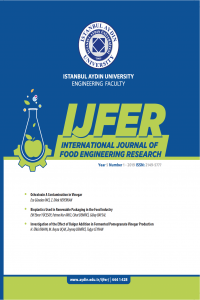Investigation of Compliance on Good manufacturing Practices (Gmp) and Hygiene Conditions in Enterprises That Supply mass Catering Services
Investigation of Compliance on Good manufacturing Practices (Gmp) and Hygiene Conditions in Enterprises That Supply mass Catering Services
Nutrition which is our basic need to be healty and to survive has changed since the old days of human history.
Mass food production and consumption has increased due to industrial revolution, rapid urbanization, rapid
increase in the number of people and women’s employment because of economic requirements. Due to
these reasons, the number of companies that engage in mass food production has increased rapidly at the
present time. In this research, mass food production in the province of İstanbul was inspected, in compliance
with the ligibility for Good Manufacturing Practices (GMP) system and hygiene regulations, according to
the two-stage audit forms. After the result of audits,67% of companies were rated successful by getting a
passing grade compliance with GMP and hygiene regulations. The remaining 33% of companies could not
receive a passing grade in audits.
Keywords:
Hygiene, , Mass Food Production, , Good Manufacturing, Practices, Gmp,
___
- [1] Aksu, H. (2012). Gıda Hijyeni ve Sanitasyon. İstanbul Aydın Üniversitesi, Anadolu Bil Meslek Yüksek Okulu, Gıda Teknolojisi Programı Ders Notları, İstanbul.
- [2] Sezgin A., Özkaya F. (2013). Toplu Beslenme Sistemlerine Genel Bakış. Akademik Gıda 12(1): 124-128.
- [3] Pellegrini, D. C. P., Paim, D. S., Lima, G. J. M. M., Kich, J. D., Coldebella, A., Cardoso, M. R. I. (2013). Application of a good manufacturing practices checklist and enumeration of total coliform in swine feed mills Semina: Ciências Agrárias, 34: 3767–3776.
- [4] Anonim, (2017). Hazır Yemek Sektörü Sektörel Bilgiler. (Erişim tarihi:01.04.2017).
- [5] Santana, N. G., Almeida, R. C. C., Ferreira, J. S., Almeida, P. F. (2009). Microbiological quality and safety of meals served to children and adoption of good manufacturing practices in public school catering in Brazil. Food Control, 20: 255–261.
- [6] Bilici, S. (2008). Toplu Beslenme Sistemleri Çalışanları İçin Hijyen El Kitabı. Ankara: T.C. Sağlık Bakanlığı Temel Sağlık Hizmetleri Genel Müdürlüğü.
- [7] Bilgin B, Erkan ÜC. (2013). Bir Hazır Yemek İşletmesinde HACCP Sisteminin Kurulması. Tekirdağ Ziraat Fakültesi Dergisi, 5 (3): 267-281.
- [8] Cevizci, S. ve Önal, A. E. (2009). Halk Sağlığı Açısından Hijyen ve İyi Üretim Uygulamaları. Türk Hijyen ve Deneysel Biyoloji Dergisi. 66, 73- 82.
- [9] Çopur, U., Yonak S. ve Şenkoyuncu, A. (2012). Gıda Güvenliği ve Denetim Sistemi, Erişim Tarihi: 22.05.2012, www.zmo.org.tr/resimler/ ekler/6bf16f1f0372a63_ek.pdf
- [10] EC-Asean Economic Cooperation (2015). Guidlines on HACCP, GMP, Comprehensive GHP for ASEAN food SMEs. http:// ec.europa.eu/food/training/haccp_en.pdf
- [11] Erkan, N., Üçok Alakavuk, D. ve Tosun, Y.Ş. (2010). Gıda Sanayinde Kullanılan Kalite Güvence Sistemleri. Journal of Fisheries Sciences, 2, 88-99.
- [12] Koç A., Bölük, G. ve Aşçı S. (2008). Gıda Güvenlik Standartlarının Gıda İmalat sanayiinde Yoğunlaşmaya Etkisi. Akdeniz Üniversitesi İktisadi ve İdari Bilimler Fakültesi Dergisi, 16, 83- 115.
- [13] Merican, Z. (2017). GMP and HACCP: are you confused? Paper Presented at Symposium on Current and Innovative Approaches to Microbiological Food Safety Managment organized by ICMSF, ILSI-SEAR, AVA. Singapore, October 3-4, 2017
- [14] Mahmutoğlu, T. (2009). Gıda Endüstrisinde “Güvenli Gıda” Üretmek. Ankara: ÖDTÜ Yayıncılık.
- [15] Merdol, T.K., Beyhan, Y., Ciğerim, N., Sağlam, F., Tayfur, M., Baş, M. ve Dağ, A. (2009). Toplu Beslenme Yapılan Kurumlarda Çalışan Personel İçin Sanitasyon-Hijyen Eğitimi Rehberi, Ankara.
- [16] Oliveira, C. A. F. de, Cruz, A. G. da, Tavolaro, P., Corassin, C. H. (2016). Food Safety: Good Manufacturing Practices (GMP), Sanitation Standard Operating Procedures (SSOP), Hazard Analysis and Critical Control Point (HACCP). Chapter 10. In: Antimicrobial Food Packaging, 129–139.
- [17] Özbek, Ş. F. ve Fidan, H. (2010) Türkiye ve Avrupa Birliğinde Gıda Standartları, Selçuk Tarım ve Gıda Bilimleri Dergisi, 1 (24), 92-99.
- ISSN: 2149-5777
- Başlangıç: 2015
- Yayıncı: İstanbul Aydın Üniversitesi
